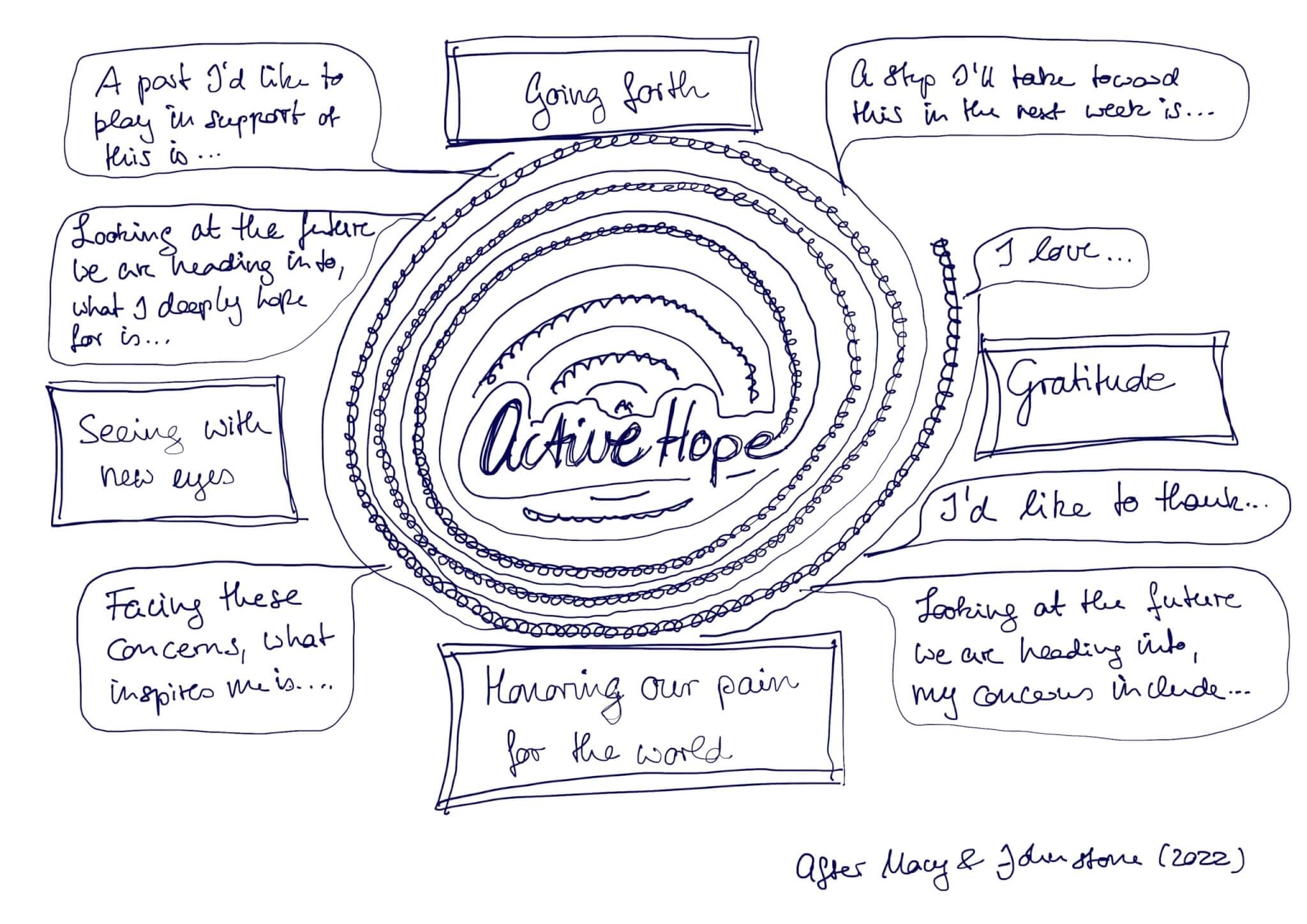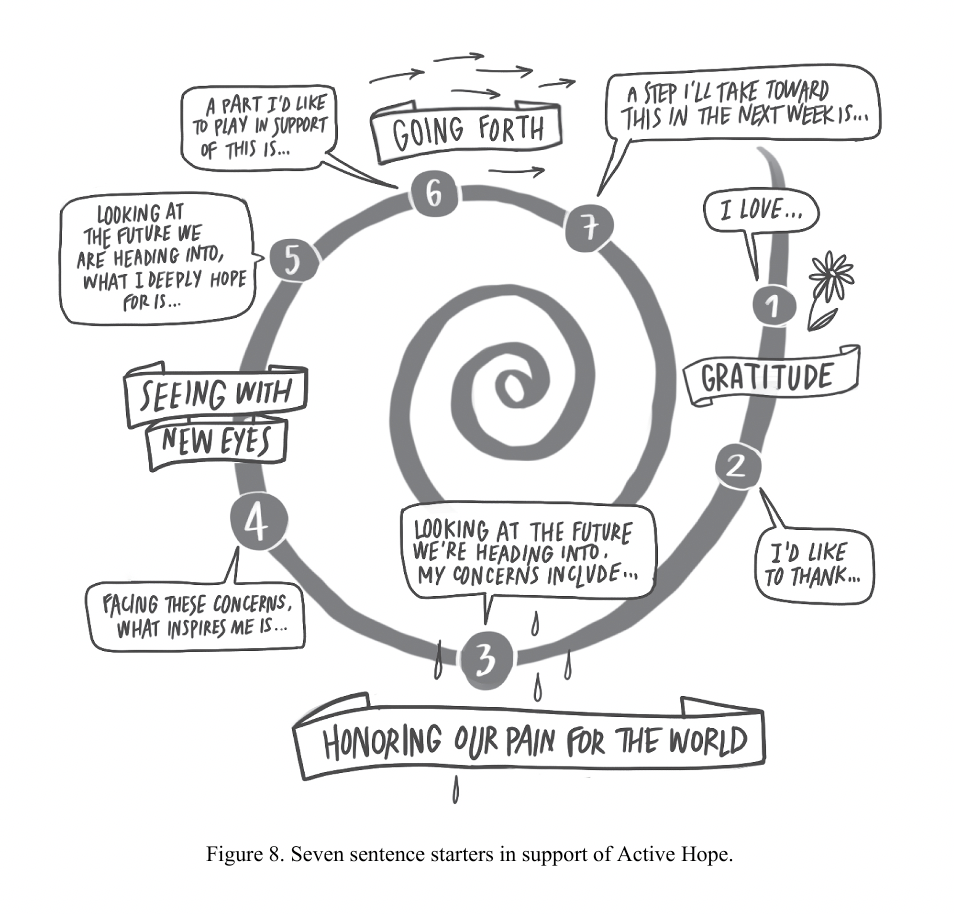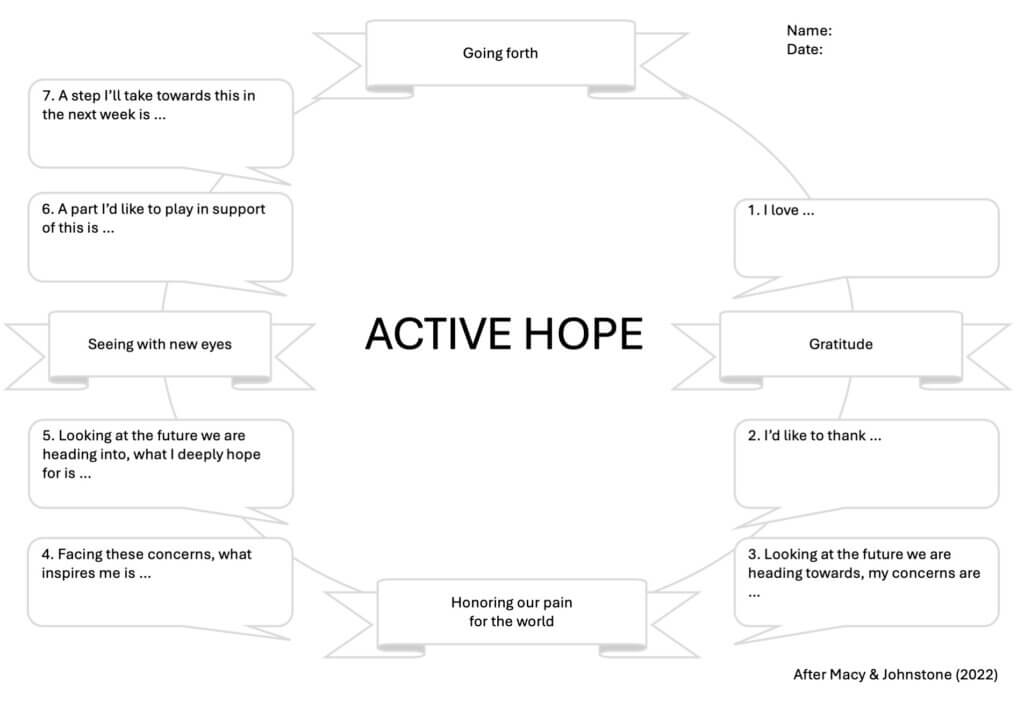
Currently reading about “Active hope” (Macy & Johnstone, 2022)
I’ve read and written about the importance of hope, especially when teaching for sustainability, before, and a book that always comes up in this context is Active hope by Macy & Johnstone (2022). And I finally got my hands on it (access via LUB)!
They write that “At the heart of this book is a collaborative model of power based on appreciating how much more we can achieve together than as separate individuals“, which I love! It is so easy to feel hopeless and alone, and it is so important to remember that it is not up to us to complete the work (but neither are we free to desist from it). One exercise suggested in the book is to draw a “support map” to become aware of the support that is already in our lives: Starting from our own name in the middle of a piece of paper, we can write up significant others around us, and draw in arrows indicating support we give and receive. This can be the basis for reflection on what more we could give and would like to receive (a bit like with our mentoring map, except looking at a much wider support network than “just” career-wise).
And then it is important which stories we want to tell, which lens we want to use to look at the world we are in: the story of “Business as Usual“, of the panicky “Great Unravelling“, or of the “Great Turning“, where we play an active part in a good future for all? The “Great Turning” is the approach to the world where we recognise the need for transformative change, practice active hope, and create something positive.
There are two main tools that absolutely stood out to me in this book. The first one is a text at the beginning of Chapter 2 (very long quote below) that I keep reading over and over again, always discovering something new in it:
“Active hope is not wishful thinking.
Active hope is not waiting to be rescued
by the Lone Ranger or by some savior.
Active hope is waking up to the beauty of life
on whose behalf we can act.
We belong to this world.
The web of life is calling us forth at this time.
We’ve come a long way and are here to play our part.
With active hope, we realize that there are adventures in store,
strengths to discover, and comrades to link arms with.
Active hope is a readiness to engage.
Active hope is a readiness to discover the strengths in ourselves and in others;
a readiness to discover the reasons for hope
and the occasions for love.
A readiness to discover the size and strength of our hearts,
our quickness of mind, our steadiness of purpose,
our own authority, our love for life,
the liveliness of our curiosity,
the unsuspected deep well of patience and diligence,
the keenness of our senses, and our capacity to lead.
None of these can be discovered in an armchair or without risk.”Joanna Macy & Chris Johnstone – Active Hope
As one way to find and access active hope, Macy & Johnstone (2022) suggest seven “sentence starters” for reflection alone or in pairs. They present them in different ways — as a list and as the spiral figure below — with the invitation to “cast yourself as a character in the story of the Great Turning“. The storyline is typical of that of an adventure story: The hero or heroine (that’s us!) faces a big challenge that seems impossible to overcome. But they bravely start their difficult journey against all offs, overcome hurdle after hurdle, and along the way learn new skills, discover new tools, make new friends, until they eventually prevail. The spiral below can help us with that journey: Starting from gratitude (which gives us “psychological buoyancy” — what a great expression!), we can face the pain we feel as a sign of deep care for the world, and start seeing new opportunities and ways to influence the world around us. The remainder of the book gives a lot more background on each of these facets, but even without repeating all of that it makes a lot of sense (and of course you are very much welcome to read the whole book!).
I started redrawing their figure to use my own version on this blog and in my workshops. But as I was doing that, I realised that the act of drawing the spiral in itself felt grounding and calming and giving me space to think about it more deeply. So I kept doodling rather than making it pretty (see featured image) and came up with a different idea…
What if I gave participants a very rudimentary sketch of a spiral, and asked them to get creative with it? Of course, they would also be welcome to redraw it from scratch, but below is my empty shell of the spiral that I want to use to invite people to work with privately; to doodle, to complete the sentences, to very slowly draw a spiral starting from the light gray circle going inwards (past all 4 phases and 7 sentence starters), closer and closer to “active hope”, or whatever feels meaningful to them. We’ll see how that goes! Of course, this is only an invitation to try to see if it feels meaningful, not a compulsory activity.
Changing topic to another point in the book that left a big impression on me: One anecdote from the book really left a big impression on me, and that was how sounding the alarm is as survival mechanism, yet people don’t always do it. Neither when it comes to the climate crisis, nor in other situations. Macy & Johnstone (2022) report on a study that investigated people (doing a questionnaire in a lab), who when alone in a room into which smoke was leaked left the room promptly, but if there were more people and the others stayed calm, they tended to stay despite smoke stinging in their eyes etc, often until “rescued” by the researcher! Scary, and even more scary when considering the implication of these mechanism at play when it comes to the climate crisis!
There are multiple reasons why people don’t sound the alarm (see also the spiral of silence): they might not believe that things are actually dangerous, or they might think that it is not their problem to sort out, or they might feel pressure to conform and don’t want to stand out from the crowd. They could also think that sounding the alarm would threaten commercial or political interests, or they might be so upset that they prefer not to think about it, or even feel paralysed — aware of danger but without a clue about what to do. Lastly, they might not see the point in doing anything since they feel that it won’t make a difference either way. Whatever the cause for inaction, in addition to the obvious danger of staying in a smoke-filled room, the other danger is that avoidance of raising the alarm and having difficult conversations can also become a habit…
And another exercise that feels extremely meaningful to me is the “tell me, who are you?” conversation that you can either have with yourself in writing, or with a partner. The trick here is to answer this question in different ways at least 10 times to see what pops up about ourselves as we dig deeper.
In any case, this is a book that is very much worth reading in peace and quiet, and that needs to be given time to develop its impact. I think for me that is still happening, so I might come back to writing about it sooner or later…
Macy, J., & Johnstone, C. (2022). Active hope (revised): How to face the mess we’re in with unexpected resilience and creative power. New World Library. (access via LUB)


Education for Sustainability: Countdown to Winterbreak Compilation – Teaching for Sustainability says:
[…] These questions are a set of 7 questions presented in a book called Active Hope. The book is available at the library, and Mirjam (Glessmer) has summarised it in a blog post where she also shares a figure with the questions posed that could be used at, for instance, workshops with colleagues: Currently reading about “Active hope” (Macy & Johnstone, 2022) – Adventures in… […]
explodingbrands.de says:
Fantastic read! I really appreciate how clearly you explained the topic—your writing not only shows expertise but also makes the subject approachable for a wide audience. It’s rare to come across content that feels both insightful and practical at the same time. At explodingbrands.de we run a growing directory site in Germany that features businesses from many different categories. That’s why I truly value articles like yours, because they highlight how knowledge and visibility can create stronger connections between people, services, and opportunities.Keep up the great work—I’ll definitely be checking back for more of your insights!